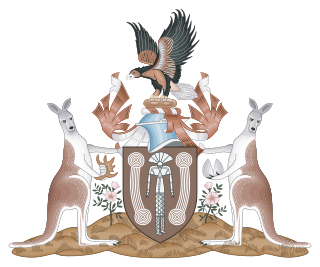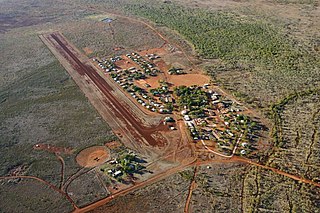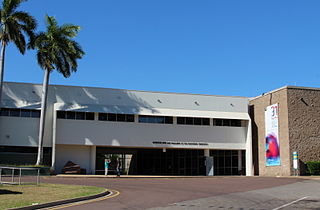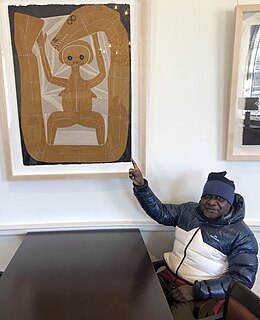
Darwin is the capital city of the Northern Territory, Australia. With an estimated population of 147,255 as of 2019, the city contains the majority of the residents of the sparsely populated Northern Territory.

The Legislative Assembly of the Northern Territory is the unicameral legislature of the Northern Territory of Australia. The Legislative Assembly has 25 members, each elected in single-member electorates for four-year terms. The voting method for the Assembly is the full-preferential voting system, having previously been optional preferential voting. Elections are on the fourth Saturday in August of the fourth year after the previous election, but can be earlier in the event of a no confidence vote in the Government. The most recent election for the Legislative Assembly was the 2020 election held on 22 August 2020. The next election is scheduled for 24 August 2024.
Maningrida, also known as Manayingkarírra and Manawukan, is an Aboriginal community in the heart of the Arnhem Land region of Australia's Northern Territory. Maningrida is 500 km (311 mi) east of Darwin, and 300 km (186 mi) north east of Jabiru. It is on the North Central Arnhem Land coast of the Arafura Sea, on the estuary of the Liverpool River.
Chips Mackinolty was involved in the campaigns against the war in Vietnam by producing posters. He was a key figure in the radical poster movement and was introduced to screen printing in Goulburn Street, Sydney.
Yuendumu is a town in the Northern Territory of Australia, 293 km (182 mi) northwest of Alice Springs on the Tanami Road, within the Central Desert Region local government area. It ranks as one of the larger remote communities in central Australia, and has a thriving community of Aboriginal artists. It is home to Pintubi Anmatjere Warlpiri (PAW) Media, which produced the TV series Bush Mechanics.

Lajamanu, formerly known as Hooker Creek Native Settlement or just Hooker Creek, is a small town of the Northern Territory of Australia. It is located around 560 km (350 mi) from Katherine and approximately 890 km (550 mi) from Darwin. At the 2016 Australian census, Lajamanu had a population of 606, of whom 89.3 percent are of Aboriginal and/or Torres Strait Islander origin, chiefly Warlpiri people.

Parap is an inner suburb of the city of Darwin, Northern Territory, Australia.

The Museum and Art Gallery of the Northern Territory (MAGNT) is the main museum in the Northern Territory. The museum is located in the inner Darwin suburb of Fannie Bay. The MAGNT is governed by the Board of the Museum and Art Gallery of the Northern Territory and is supported by the Museums and Art Galleries of the Northern Territory Foundation. Each year the MAGNT presents both internally developed exhibitions and travelling exhibitions from around Australia. It is also the home of the annual Telstra National Aboriginal and Torres Strait Islander Art Award, Australia's longest-running set of awards for Indigenous Australian artists.

Makinti Napanangka was a Pintupi-speaking Indigenous Australian artist from Australia's Western Desert region. She was referred to posthumously as Kumentje. The term Kumentje was used instead of her personal name as it is customary among many indigenous communities not to refer to deceased people by their original given names for some time after their deaths. She lived in the communities of Haasts Bluff, Papunya, and later at Kintore, about 50 kilometres (31 mi) north-east of the Lake MacDonald region where she was born, on the border of the Northern Territory and Western Australia.
Contemporary Indigenous Australian art is the modern art work produced by Indigenous Australians, that is, Aboriginal Australians and Torres Strait Islander people. It is generally regarded as beginning in 1971 with a painting movement that started at Papunya, northwest of Alice Springs, Northern Territory, involving Aboriginal artists such as Clifford Possum Tjapaltjarri and Kaapa Tjampitjinpa, and facilitated by white Australian teacher and art worker Geoffrey Bardon. The movement spawned widespread interest across rural and remote Aboriginal Australia in creating art, while contemporary Indigenous art of a different nature also emerged in urban centres; together they have become central to Australian art. Indigenous art centres have fostered the emergence of the contemporary art movement, and as of 2010 were estimated to represent over 5000 artists, mostly in Australia's north and west.
Jimmy Pike (c1940-2002) was a Walmatjarri Aboriginal artist.
The Darwin Festival, founded as the Bougainvillea Festival in 1979 and named Festival of Darwin from 1996 to 2002, is an annual arts festival in Darwin, Northern Territory. It celebrates the multicultural aspects of the Northern Territory lifestyle. The festival is held over 18 days in August and comprises a series of events including outdoor concerts, workshops, theatre, dance music, comedy, cabaret, film and visual arts. The Darwin Aboriginal Art Fair is held under the umbrella of the festival, and the Garma Festival, NATSIAA art awards, and National Indigenous Music Awards are within the festival period.
Marina Strocchi is an internationally-exhibited Australian painter and printmaker whose work is held in many national collections. Strocchi is based in Alice Springs and has worked extensively with Aboriginal artists in Central Australia.
Therese Ritchie is an Australian contemporary artist, writer and graphic designer, based in Darwin in the Northern Territory.
Barbara Mbitjana Moore is an Anmatyerre woman who grew up in Ti-Tree in the Northern Territory, moving later to Amata in South Australia's Anangu Pitjantjatjara Yankunytjatjara (APY) Lands. In April 2003, Moore began painting at Amata's Tjala Arts, and, since then, has received widespread recognition. Moore won a National Aboriginal & Torres Strait Islander Art Award in 2012 and has been a finalist in many other years. Moore has also been a finalist for the Wynne Prize.

Joe Guymala is an Aboriginal Australian artist and musician of the Burdoh clan of the Kunwinjku people, known for his paintings on bark, paper and memorial poles known as lorrkkon.
Gertie Huddleston (c.1916/1933–2013) was an contemporary Indigenous Australian artist who worked in the Ngukurr community.
Malaluba Gumana is an Australian Aboriginal artist from northeast Arnhem Land, who has gained prominence through her work in painting and the production of larrakitj, the memorial poles traditionally used by Yolngu people in a mortuary ceremony.

Wukun Wanambi was an Australian Yolngu painter, filmmaker and curator of the Marrakulu clan of northeastern Arnhem Land.
Anniebell Marrngamarrnga is an Aboriginal Australian artist from Maningrida in the Northern Territory of Australia. She is well known for her large-scale, intricate fibre sculptures.







